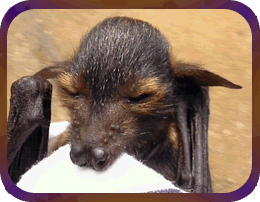
Report
from Tolga Bat Hospital
by Jenny Maclean
(from FFNFF Newsletter Edition 5, January 2000)
The Spectacled flying foxes wintered over at Tolga again this year so we have had bats admitted to the hospital throughout the year. The Little Red flying foxes visited Tolga Scrub in small numbers in November, unlike last year when they visited 3 times in much larger numbers.
Tick Paralysis
This has been a good year for tick paralysis thanks to the southern oscillation
index. We have had lots of rain which for unknown reasons rneans that
the paralysis ticks and the Spectacled flying foxes have a lot less contact.
We found 58 live adults with tick paralysis and 22 dead ones. Last year it was 200 and 100 respectively. Of the 51 live adults (7 were euthanased), 41 were female - 30 with babies, 11 without and 3 pregnant. There were only 10 males. 11 of the 22 dead were females with babies, though most had live babies. It would appear that the colony are breeding well.
 Orphans
Orphans
There were a lot of abandoned babies late in the season. Unfortunately
these older babies do not usually fall to the ground until they are dead.
There were 14 live lone babies, 33 dead and 4 with cleft palates.
We fostered out 12 babies and to date have received 34 back for release! The extras are from Ingham, Daintree and Cairns area. In total we have about 60 orphans for release.
This year we plan to try to release at the colony. Release last year from my home was very slow - we surmise because of the prolonged rains. Helen and Kevin Adams are helping with the design and construction of a vandal-proof winch system to a cage in the canopy.
Census
The March and November 1999 census data showed there were about 5000 Spectacleds
at Tolga Scrub. If they winter over at Tolga again in 2000, there are
plans to count them - in August as well. The other colonies on the Tablelands
did not fare so well. For the first time in living memory, the Spectacleds
did not return to the Whiteing Road colony, nor to the other maternity
colonies at Zillie Fails and Powley Road. Only about 1000 returned to
Topaz.
Media
We have had 6 international photographers/photojournalists visit in 1999.
Most recently, we were visited for a story on flying foxes that will appear
in magazines for Australian Geographic and the Smithsonian Institute.
We have been contacted for comment on flying fox stories by the local ABC radio and The Courier Mail newspaper. The film made for National Geographic at the end of last year has not yet been shown on overseas television so we have been unable to get a copy. It is part of a series called 'Mission Wild'.
Birth defects
It is difficult to compare the statistics for birth defects this year
to last. Last year we were in the Scrub twice a day during the main birthing
time as there were a large number of adults with tick paralysis. This
year we were only checking every 2 or 3 days, time for these babies to
have been scavenged. We had 4 babies this year with severe cleft palate
compared to 30 last year.
 Volunteers
Volunteers
During the tick paralysis season, we had a German volunteer for 1 week
and a Sydney volunteer for 1 week. Our trusted local volunteers were indispensable
as usual.
Fund-raising
We have T-shirts and posters for sale and charge photographers/journalists
for our time. We have a bed and breakfast for people interested in wildlife
and accept readily any donations. TREAT donated $200 this year.
Bat Tourism
We have a 3 year permit from National Parks for the display of flying
foxes at the hospital, as well as a separate 3 year education permit for
work in the community. We hope to attract rich tourists with a keen interest
in wildlife, mainly through tour groups.
Education
The education work is very broadly based. It includes:
1. Our website www.athertontablelands.com/bats was finally put up in September. We subscribe to a listserv for bats called Batline and use it to keep the bat world informed of bat activities in our area.
2. Printing of 2 posters, thanks to Bronwyn from the Barron River Integrated Catchment Management Authority. They are Flying Foxes of the Atherton Tablelands and Tolga Bat Rescue. A third, Microbats of the Atherton Tablelands, is also planned.
3. Education days
with
* Atherton Primary School through TREAT on TAP
* Vacation Care program
* National Parks holiday program
* FNQ Wildlife Rescue
* Tree Kangaroo and Mammal Group
4. Education stalls at the Yungaburra Markets and the Ecofair in Cairns.
5. Planning with the Tinaroo Environmental Centre on the development of educational material and curriculum on bats for children 6-8 years old.
